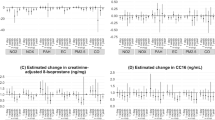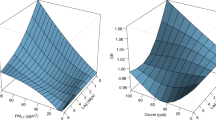Abstract
Exposure to particulate matter less than 2.5 microns from either ambient pollution (AMB-PM2.5) or secondhand smoke (SHS-PM2.5) have been associated with asthma worsening, but there is little information on effects and relative potency with concurrent exposures. We studied health effects of concurrent exposures to AMB-PM2.5 and SHS-PM2.5 over a 6-year period in schoolchildren with asthma. Regression calibration with instrumental variables (RCIV) was utilized to estimate effects of personal exposure to low-level SHS and AMB-PM2.5 on daily albuterol usage and urinary leukotriene E4 (uLTE4; a biomarker of asthma-related inflammation) using urine cotinine and concentrations from fixed and personal pollution monitors. Each IQR increase in SHS-PM2.5 exposure was associated with a 6.7% increase (95% CI: 1.0–12.8%) in uLTE4 on the same day and 9.4% increase (95% CI: −2.6 to 22.7%) in albuterol use the next day, when children were co-exposed to mean levels of AMB-PM2.5. The dose-response relationship between health outcomes and one pollutant was higher at lower levels of the other pollutant. For example, at lower levels of predicted SHS-PM2.5 exposure, increases in health outcomes per IQR increase in AMB-PM2.5 ranged between 2 and 5%, but were negligible at higher SHS-PM2.5 levels. Comparing at equivalent co-exposure levels, SHS-PM2.5 was 1.6 times more potent than AMB-PM2.5 for uLTE4 (95% CI: 1.1–2.3); estimates for albuterol usage were similar but less significant. Effects at mean co-exposure levels were closer [SHS to AMB-PM2.5 potency ratio = 1.2 (95% CI: 0.9–1.5) for uLTE4 and 1.2 (95% CI: 0.7–1.9) for albuterol usage]. In summary, concurrent exposure to relatively low levels of SHS and AMB-PM2.5 were associated with health outcomes in asthmatic schoolchildren. Dose responses varied with changes in the relative amounts of each pollutant; SHS-PM2.5 was observed to be more potent than AMB-PM2.5 when co-exposure levels were equivalent.
This is a preview of subscription content, access via your institution
Access options
Subscribe to this journal
Receive 6 print issues and online access
$259.00 per year
only $43.17 per issue
Buy this article
- Purchase on Springer Link
- Instant access to full article PDF
Prices may be subject to local taxes which are calculated during checkout

Similar content being viewed by others
References
Zheng XY, Ding H, Jiang LN, Chen SW, Zheng JP, Qiu M, et al. Association between air pollutants and asthma emergency room visits and hospital admissions in time series studies: a systematic review and meta-analysis. PLoS ONE. 2015;10:e0138146.
Schwartz J, Bind M-A, Koutrakis P. Estimating causal effects of local air pollution on daily deaths: effect of low levels. Environ Health Perspect. 2017;125:23–29.
Adams K, Greenbaum DS, Shaikh R, van Erp AM, Russell AG. Particulate matter components, sources, and health: Systematic approaches to testing effects. J Air Waste Manag Assoc. 2015;65:544–58.
Jin W, Su S, Wang B, Zhu X, Chen Y, Shen G, et al. Properties and cellular effects of particulate matter from direct emissions and ambient sources. J Environ Sci Health. 2016;51:1075–83.
Centers for Disease Control and Prevention. Vital signs: disparities in nonsmokers’ exposure to secondhand smoke—United States, 1999–2012. Morbidity Mortal Wkly Rep. 2015;64:103–8. Accessed 16 Jan 2019.
Benowitz NL, Jain S, Dempsey DA, Nardone N, Helen GS, Jacob P 3rd. Urine cotinine screening detects nearly ubiquitous tobacco smoke exposure in urban adolescents. Nicotine Tob Res. 2017;19:1048–54.
Chilmonczyk BA, Salmun LM, Megathlin KN, Neveaux LM, Palomaki GE, Knight GJ, et al. Association between exposure to environmental tobacco smoke and exacerbations of asthma in children. N. Engl J Med. 1993;328:1665–9.
Ciaccio CE, Gurley-Calvez T, Shireman TI. Indoor tobacco legislation is associated with fewer emergency department visits for asthma exacerbation in children. Ann Allergy Asthma Immunol. 2016;117:641–5.
Pope CA 3rd, Burnett RT, Krewski D, Jerrett M, Shi Y, Calle EE, et al. Cardiovascular mortality and exposure to airborne fine particulate matter and cigarette smoke: shape of the exposure-response relationship. Circulation. 2009;120:941–8.
Burnett RT, Pope CA 3rd, Ezzati M, Olives C, Lim SS, Mehta S, et al. An integrated risk function for estimating the global burden of disease attributable to ambient fine particulate matter exposure. Environ Health Perspect. 2014;122:397–403.
Strand M, Vedal S, Rodes C, Dutton SJ, Gelfand EW, Rabinovitch N. Estimating effects of ambient PM2.5 exposure on health using PM2.5 component measurements and regression calibration. J Exp Sci Environ Epi. 2006;16:30–8.
Strand M, Hopke PK, Zhao W, Vedal S, Gelfand E, Rabinovitch N. A study of health effect estimates using competing methods to model personal exposures to ambient PM2.5. J Expo Sci Environ Epidemiol. 2007;17:549–58.
Hoffman BC, Rabinovitch N. Urinary leukotriene E4 as a biomarker of exposure, susceptibility, and risk in asthma: an update. Immunol Allergy Clin North Am. 2018;38:599–610.
Strand M, Sillau S, Grunwald GK, Rabinovitch N. Regression calibration for models with two predictor variables measured with error and their interaction, using instrumental variables and longitudinal data. Stat Med. 2014;33:470–87.
Strand M, Sillau S, Grunwald GK, Rabinovitch N. Regression calibration with instrumental variables for longitudinal models with interaction terms, and application to air pollution studies. Environmetrics. 2015;26:393–405.
Urbano FL. Review of the NAEPP 2007 expert panel report (EPR-3) on asthma diagnosis and treatment guidelines. J Manag Care Pharm. 2008;14:41–9.
Rabinovitch N, Strand M, Gelfand EW. Particulate levels are associated with early asthma worsening in children with persistent disease. Am J Respir Crit Care Med. 2006;173:1098–105.
Rabinovitch N, Silveira L, Gelfand EW, Strand M. The response of children with asthma to ambient particulate is modified by tobacco smoke exposure. Am J Resp Crit Care Med. 2011;184:1350–7.
Carroll RJ, Ruppert D, Stephanski LA. Measurement Error in Nonlinear Models: A Modern Perspective. 2nd edition. Boca Raton: Chapman and Hall/CRC; 2006.
Delfino RJ, Quintana PJ, Floro J, Gastañaga VM, Samimi BS, Kleinman MT, et al. Association of FEV1 in asthmatic children with personal and microenvironmental exposure to airborne particulate matter. Environ Health Perspect. 2004;112:932–41.
Rabinovitch N, Adams CD, Strand M, Koehler K, Volckens J. Within-microenvironment exposure to particulate matter and health effects in children with asthma: a pilot study utilizing real-time personal monitoring with GPS interface. Environ Health. 2016;15:96.
Matt GE, Quintana PJ, Destaillats H, et al. Thirdhand tobacco smoke: emerging evidence and arguments for a multidisciplinary research agenda. Environ Health Perspect. 2011;119:1218–26.
Williams R, Suggs J, Creason J, Rodes C, Lawless P, Kwok R, et al. The 1998 Baltimore particulate matter epidemiology-exposure study: part 2. Personal exposure assessment associated with an elderly study population. J Expo Anal Environ Epidemiol. 2000;10:533–43.
Martins-Green M, Adhami N, Frankos M, Valdez M, Goodwin B, Lyubovitsky J, et al. Cigarette smoke toxins deposited on surfaces: implications for human health. PLoS One. 2014;9:e86391.
Goettel M, Niessner R, Scherer M, Scherer G, Pluym N. Analysis of urinary eicosanoids by LC-MS/MS reveals alterations in the metabolic profile after smoking cessation. Chem Res Toxicol. 2018;31:176–82.
Turner MC, Cohen A, Jerrett M, Gapstur SM, Diver WR, Pope CA 3rd, et al. Interactions between cigarette smoking and fine particulate matter in the Risk of Lung Cancer Mortality in Cancer Prevention Study II. Am J Epidemiol. 2014;180:1145–9.
Acknowledgements
We would like to thank Arden Pope for his review and helpful comments on this paper.
Author information
Authors and Affiliations
Corresponding author
Ethics declarations
Conflict of interest
The authors declare that they have no conflict of interest.
Additional information
Publisher’s note Springer Nature remains neutral with regard to jurisdictional claims in published maps and institutional affiliations.
Rights and permissions
About this article
Cite this article
Strand, M., Rabinovitch, N. Health effects of concurrent ambient and tobacco smoke-derived particle exposures at low concentrations in children with asthma. J Expo Sci Environ Epidemiol 30, 785–794 (2020). https://doi.org/10.1038/s41370-020-0201-y
Received:
Revised:
Accepted:
Published:
Issue Date:
DOI: https://doi.org/10.1038/s41370-020-0201-y
Keywords
This article is cited by
-
The use of asthma and allergy medicines is associated with exposure to smoking
Nature Water (2023)



